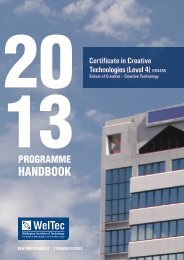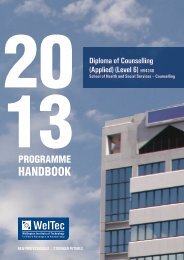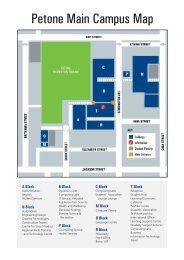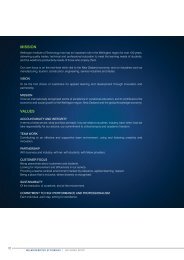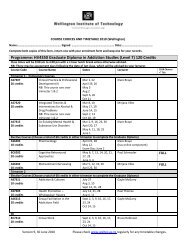HANDBOOK - Wellington Institute of Technology
HANDBOOK - Wellington Institute of Technology
HANDBOOK - Wellington Institute of Technology
Create successful ePaper yourself
Turn your PDF publications into a flip-book with our unique Google optimized e-Paper software.
PROGRAMME<strong>HANDBOOK</strong>Graduate Diploma inManagement HV4490School <strong>of</strong> Business and IT– Business and Management
DisclaimerThe information contained in this Programme Handbook is correct at the time <strong>of</strong> publication. However, programmes and coursesare subject to change and WelTec reserves the right to change the content, location or method <strong>of</strong> presentation <strong>of</strong> anyprogramme or course, and update this Programme Handbook accordingly at any time. The online edition <strong>of</strong> the ProgrammeHandbook is the <strong>of</strong>ficial Programme Handbook.Copyright © 2013<strong>Wellington</strong> <strong>Institute</strong> <strong>of</strong> <strong>Technology</strong> owns copyright in this programme handbook. No part may be reproduced, stored in a retrievalsystem or <strong>of</strong>fered for resale without WelTec’s written permission.<strong>Wellington</strong> <strong>Institute</strong> <strong>of</strong> <strong>Technology</strong> - 2013 Programme Handbook February 2013HV4490 Graduate Diploma in Management
School <strong>of</strong> Business and ITPROGRAMME <strong>HANDBOOK</strong> 2013HV4490Graduate Diploma in Management<strong>Wellington</strong> <strong>Institute</strong> <strong>of</strong> <strong>Technology</strong> - 2013 Programme HandbookHV4490 Graduate Diploma in ManagementPublication Date: 1 March 2013
HAERE MAIWhai korōria ki te atua i runga rawaMaunga rongo ki te whenuaWhakaaro pai ki ngā Tangata Katoa.Tena Koutou Katoa,Tēnei te mihi atu ki a koutou ngā Tauira oTe Whare Wananga o Te Awakairangi.Nau mai haere mai ki tēnei Wananga o tātou.Kia kaha koutou ki te whai mātauranga i tēnei tau, ki te whakarongohoki ki ō koutou kaiako.“Whāia te kotahitanga o te wairua.Mā te rangimārie me te aroha e paihere”(pursue unity <strong>of</strong> spirit, which is bound together by peace and aroha)He mihi nui tēnei kia koutou ngā Tauira oTe Whare Wananga o Te Awakairangi.Nau mai haere mai ki tēnei Whare Wananga o tātou.<strong>Wellington</strong> <strong>Institute</strong> <strong>of</strong> <strong>Technology</strong> - 2013 HV4490 Programme Handbook February 2013Overview and Programme Specific Information Page 4
CONTENTSHAERE MAI............................................................................................................................................. 4CHIEF EXECUTIVE’S WELCOME ......................................................................................................... 6EXECUTIVE DEAN’S WELCOME .......................................................................................................... 7INTRODUCTION ..................................................................................................................................... 7ACADEMIC CALENDAR - 2013 ............................................................................................................. 8STAFF ................................................................................................................................................... 10AIMS ...................................................................................................................................................... 10GRADUATE PROFILE .......................................................................................................................... 11CAREERS ............................................................................................................................................. 12STAIRCASING ...................................................................................................................................... 12PROGRESS THROUGH THE PROGRAMME ..................................................................................... 12GRADUATION CRITERIA .................................................................................................................... 12LEARNING AND TEACHING................................................................................................................ 13ASSESSMENT PROCEDURES ........................................................................................................... 14Assessment Rationale ................................................................................................................ 14Assessment Schedule ................................................................................................................ 15Format Of Assessments ............................................................................................................. 15Guidelines For Assignment Writing ............................................................................................ 15Assessment Cover Sheets ......................................................................................................... 15Submitting Assessment And Assignment Work ......................................................................... 16Arranging for Late Submission Of Assessments ........................................................................ 16Applying For An Extension Beyond The Course End Date ........................................................ 16Penalty for Unarranged Late Submission ................................................................................... 16Reassessment Of Assessments ................................................................................................. 16Assessment Results Notification ................................................................................................ 16Challenging Assessment Decisions ............................................................................................ 17RISK MANAGEMENT, SAFETY AND HEALTH ................................................................................... 17ATTENDANCE MATTERS .................................................................................................................... 17REQUIRED TEXTS ............................................................................................................................... 18STATIONERY REQUIREMENTS ......................................................................................................... 18EMPLOYMENT ..................................................................................................................................... 18ETHICS ................................................................................................................................................. 18INFORMED CONSENT AND CONFIDENTALITY................................................................................ 18PROGRAMME EVALUATION .............................................................................................................. 18COURSE DESCRIPTORS .................................................................................................................... 20<strong>Wellington</strong> <strong>Institute</strong> <strong>of</strong> <strong>Technology</strong> - 2013 HV4490 Programme Handbook February 2013Overview and Programme Specific Information Page 5
WELCOME TO WELTECCHIEF EXECUTIVE’S WELCOMEGreetings, Kia Ora, Tal<strong>of</strong>a Lava, Kia Orana, ni sa Bula VinakaKaise Hai, Sat sri akal, Malo e Lelei, Halo Olgeta, Taloha niMarhaba, Bozu, Fakal<strong>of</strong>a Lahi Atu, Annyong haseyo, Ni hao, NamasteWelcome to <strong>Wellington</strong> <strong>Institute</strong> <strong>of</strong> <strong>Technology</strong>Te Whare Wananga o te AwakairangiIn selecting to learn at <strong>Wellington</strong> <strong>Institute</strong> <strong>of</strong> <strong>Technology</strong> (WelTec), you have chosen a place <strong>of</strong>learning that aims to give you not only the working lifestyle you want, but also, a friendly andcomfortable environment where you can feel at home.By enrolling at WelTec, you are setting out on a learning journey. What you learn and for whatpurpose, are your decisions to make. We want to walk beside you as your coach, partner andmentor; <strong>of</strong>fering support, facilities, opportunities, tools and information to help you reach yourgoals.When you enrol, you will find that the majority, or maybe all, <strong>of</strong> your courses take place on onecampus. Whether your classes are held at our <strong>Wellington</strong> sites, in Auckland, Christchurch, any <strong>of</strong> ourPetone or other sites, all are your campuses.With your Student ID card, all services and facilities are there for you to use.Please let us know if you have any queries or needs we haven’t yet met. Best wishes for a happy andsuccessful year.Linda Sissons (Dr)Chief Executive<strong>Wellington</strong> <strong>Institute</strong> <strong>of</strong> <strong>Technology</strong> - 2013 HV4490 Programme Handbook February 2013Overview and Programme Specific Information Page 6
EXECUTIVE DEAN’S WELCOMEWelcome to WelTec – your place for learning. As an institute <strong>of</strong> learning you, as a student, are ourkey priority.All staff at WelTec have one primary focus and that is to help facilitate your learning. As youprogress through your studies please take the opportunity to access the facilities and staff supportavailable.Your success is our success.Julia Hennessy (MEd, MMgt, PGDipHSM, BA, DipN)Executive DeanINTRODUCTIONThis Programme Handbook is intended to provide information relating to the programme youare enrolled in with WelTec. There is also an associated WelTec A-Z site that has otherhelpful information regarding systems and processes that operate at WelTec.The most up-to-date version <strong>of</strong> this Programme Handbook and the WelTec A-Z generalinformation is online at:http://www.weltec.ac.nz/SH/HV4490.pdfWelTec’s policies that apply to students and this Programme Handbook are located at:http://www.weltec.ac.nz/SH/Policy/<strong>Wellington</strong> <strong>Institute</strong> <strong>of</strong> <strong>Technology</strong> - 2013 HV4490 Programme Handbook February 2013Overview and Programme Specific Information Page 7
TRIMESTER ONE 2013TRIMESTER TWO 2013ACADEMIC CALENDAR - 2013HV4490 Graduate Diploma in ManagementTeachingPeriodWeekNoMondaydate5 28-Jan67 11-FebMON TUE WED THU FRI SAT SUNAucklandAnniversaryWaitangiDay8 18-FebOrientationChristchurchOrientationAucklandOrientationAuckland9 25-FebOrientationPetoneOrientationPetone,Church StOrientationPetone10 4-Mar Tri 1 Starts11 11-Mar 12 18-Mar13 25-Mar Tri 1+2 Easter Break14 1-Apr Easter Break Easter Break 15 8-AprEasterBreakEasterBreak16 15-AprStudyBreakStudyBreakStudyBreakStudyBreakStudyBreak17 22-Apr ANZAC Day18 29-Apr19 6-May20 13-May21 20-May22 27-May23 3-Jun24 10-JunQueen’sBirthdayStudyBreakStudyBreakStudyBreakStudyBreakStudyBreak25 17-Jun EXAMS EXAMS EXAMS EXAMS EXAMS26 24-Jun EXAMS EXAMS EXAMS EXAMS Tri 1 Ends27 1-Jul28 8-JulTri 1 ResultsCompleted29 15-Jul Tri 2 Starts30 22-Jul 31 29-Jul 32 5-Aug 33 12-AugGraduation<strong>Wellington</strong>34 19-Aug35 26-Aug36 2-SepStudyBreakStudyBreakStudyBreakStudyBreakStudyBreak37 9-Sep38 16-Sep39 23-Sep40 30-Sep41 7-Oct42 14-Oct <strong>Wellington</strong> <strong>Institute</strong> <strong>of</strong> <strong>Technology</strong> - 2013 HV4490 Programme Handbook February 2013Overview and Programme Specific Information Page 8
TRIMESTER THREE – 2013TeachingPeriodWeekNoMondaydate43 21-OctMON TUE WED THU FRI SAT SUNStudyBreakStudyBreakStudyBreakStudyBreakStudyBreak44 28-Oct Labour Day EXAMS EXAMS EXAMS EXAMS45 4-Nov EXAMS EXAMS EXAMS EXAMS Tri 2 Ends46 11-Nov Tri 3 Starts47 18-Nov48 25-NovCanterburyAnniversaryTri2 ResultsCompleted49 2-Dec50 9-Dec51 16-Dec52 23-Dec WelTec closed for Christmas123456789101130-Dec-136-Jan-1413-Jan-1420-Jan-1427-Jan-143-Feb-1410-Feb-1417-Feb-1424-Feb-143-Mar-1410-Mar-14<strong>Wellington</strong>AnniversaryAucklandAnniversaryWelTec closed for New Year HolidaysWaitangi DayEXAMS EXAMS EXAMS EXAMS EXAMSTri 1 StartsTri 3 EndsTri 3 ResultsCompleted Last date to change or withdraw with refund Last date to withdraw (75% <strong>of</strong> course duration)The up-to-date, day-to-day and week-by-week timetables are located at:http://timetable.weltec.ac.nz/.<strong>Wellington</strong> <strong>Institute</strong> <strong>of</strong> <strong>Technology</strong> - 2013 HV4490 Programme Handbook February 2013Overview and Programme Specific Information Page 9
STAFFFaculty Executive Dean:Julia HennessySchool:Business and ITHead <strong>of</strong> School:Mick JaysPhone/extension 670E-mailmick.jays@weltec.ac.nzAssociate Head <strong>of</strong> School: TBAPhone/extensionTBAE-mailTBASchool Business Administrator: Glynis ValliPhone/extension 830 3149E-mailGlynis.Valli@weltec.ac.nzStaff Member Qualifications Position Email AddressPetone Campus: 0800 WELTEC (935 832)BROUGHTON, Greg BCA, CertAdultEd, CA SASM Greg.Broughton@weltec.ac.nzKEITH, Michael MMgt, BSSc, GradCertED SASM Michael.Keith@weltec.ac.nzPETER, Cyril JP MIHM, CertAdult Ed SASM Cyril.Peter@weltec.ac.nzSENO, Leah Ingrid BS, DipAppMgt, CertOrgDvpt, ASM Leah.Seno@weltec.ac.nzCertDevTrainProgSMITH, Peter MA ASM Peter.Smith@weltec.ac.nzZWIEGELAAR, Jeremy MA (Hons), GradDipTchg, ASM Jeremy.Zwiegelaar@weltec.ac.nzMcNICOL, John BIT, HDipEd, CTT ASM John.McNicol@weltec.ac.nzSHAW, Glenda MBA Exec ASM Glenda.Shaw@weltec.ac.nzWILLIAMS, Janine BA(Hons), DipExSci ASM Janine.Williams@weltec.ac.nzJIN, Shan MPr<strong>of</strong>Acc ASM Shan.Jin@weltec.ac.nzMATHESON, Ainslie MBS, BCA Acc & Comm Law, ASM Ainslie.Matheson@weltec.ac.nzDipTchgDAWSON, Dennis ME, MBA ASM Dennis.Dawson@weltec.ac.nzAIMSMajoring in Organisational Development is designed to:• introduce and develop students in the key areas <strong>of</strong> business required to facilitate a careerpathway in organisational development and / or aligned fields in business and management• provide a vehicle for people with relevant employment history and experience todemonstrate their acquired knowledge and competence in various organisational contexts,and attain credentials• provide a staircase to higher level studyMajoring in Human Resources is designed to:• contribute to the development <strong>of</strong> a lasting pr<strong>of</strong>essional interest and career in humanresource management• provide a vehicle for people with relevant employment history and experience todemonstrate their acquired knowledge and competence in human resource management invarious organisational contexts, and attain credentials<strong>Wellington</strong> <strong>Institute</strong> <strong>of</strong> <strong>Technology</strong> - 2013 HV4490 Programme Handbook February 2013Overview and Programme Specific Information Page 10
• provide a staircase to higher level studyMajoring in Hospitality is designed to:• introduce and develop students in the key areas <strong>of</strong> business required to facilitate a careerpathway in international hospitality management and / or aligned fields in the wider serviceand tourism industries.• provide a vehicle for people with relevant employment history and experience todemonstrate their acquired knowledge and competence in various organisational contexts,and attain credentials• provide a staircase to higher level studyGRADUATE PROFILEOrganisational Development StrandIn a range <strong>of</strong> diverse and changing organisational contexts graduates will be able toeffectively:• Add value by applying specific business management techniques• Communicate information, arguments, and analyses in a variety <strong>of</strong> forms, to specialist andnon-specialist audiences that includes the critical judgment <strong>of</strong> the organisationaldevelopment field and function• Apply critical problem solving skills with initiative and judgement• Recognise ethical and cultural issues inherent in decision making• Work independently and within teams <strong>of</strong> diverse people• Apply the language <strong>of</strong> organisational developmentHuman Resource StrandIn a range <strong>of</strong> diverse and changing organisational contexts graduates will be able toeffectively:• Add value by applying specific human resource management techniques• Communicate information, arguments, and analyses in a variety <strong>of</strong> forms, to specialist andnon-specialist audiences that includes the critical judgment <strong>of</strong> the human resource functionand how people can best bring performance to an organisation• Apply critical problem solving skills with initiative and judgement• Recognise ethical and cultural issues inherent in the HR process• Work independently and within teams <strong>of</strong> diverse people• Apply the language <strong>of</strong> human resource management• Interpret and apply human resource legislationHospitality StrandIn a range <strong>of</strong> diverse and changing hospitality industry contexts graduates will be able toeffectively:• Add value by applying specific hospitality management techniques• Communicate information, arguments, and analyses in a variety <strong>of</strong> forms, to specialist andnon-specialist audiences, that includes the critical judgment <strong>of</strong> the hospitality managementfunction• Apply critical problem solving skills with initiative and judgement• Recognise ethical and cultural issues inherent in the hospitality industry• Work independently and within teams <strong>of</strong> diverse people<strong>Wellington</strong> <strong>Institute</strong> <strong>of</strong> <strong>Technology</strong> - 2013 HV4490 Programme Handbook February 2013Overview and Programme Specific Information Page 11
• Apply the language <strong>of</strong> hospitality management• Interpret and apply hospitality industry legislationGraduates will also have the appropriate skills and knowledge to pursue further study andpr<strong>of</strong>essional development opportunities.CAREERSStudents will develop knowledge and understanding <strong>of</strong> the theory and practical applications<strong>of</strong> strategic management, human resource management, leadership, project management,change management, business analytics and intelligence, and organisational behaviour,preparing graduates for career opportunities across a wide spectrum <strong>of</strong> industry in a number<strong>of</strong> disciplines, including:• Organisational Development and Change• Project Management• Human Resources• General Management• Business Ownership.STAIRCASINGStudents graduating with the Graduate Diploma in Management• Progress to graduate study at other Tertiary <strong>Institute</strong>s• Pursue further undergraduate study at WelTec or other Tertiary <strong>Institute</strong>s• Enter the work force.PROGRESS THROUGH THE PROGRAMMEThis programme will normally be completed in 2 trimesters <strong>of</strong> full time study. The trimestersdo not have to be consecutive.The programme must be completed within a 3 year time frame.GRADUATION CRITERIAAll courses are 15 credits. To successfully complete a diploma, you must achieve a total <strong>of</strong>120 credits (8 x 15 credit courses), with a minimum <strong>of</strong> 75 credits at level 7.There is one level 5 course (BM5001) common to all 3 strands, which is compulsory forinternational students and others who lack a grounding in business studies. This course isdesigned to orient these students in business study in New Zealand, as well as assistingwith, and developing their academic writing and referencing skills.Students will be required to complete this course in their first trimester <strong>of</strong> study.Each strand contains two compulsory level 6 courses which provide requisite knowledgeand skill required to complement learning at level 7.At level 7 you are required to complete from three to five compulsory courses (depending onstrand) which focus on key knowledge and skills relevant to the fields <strong>of</strong> OrganisationalDevelopment, Human Resources and Hospitality.Elective choice allows you some flexibility to study an associated area <strong>of</strong> business ormanagement, or explore a concept or problem relevant to your field <strong>of</strong> study by taking(BM7009) contemporary issues.<strong>Wellington</strong> <strong>Institute</strong> <strong>of</strong> <strong>Technology</strong> - 2013 HV4490 Programme Handbook February 2013Overview and Programme Specific Information Page 12
More specific detail <strong>of</strong> structure and student enrolment is contained in the tables below.Organisational Development StrandInternational studentenrolmentDomestic student enrolment1 x level 5 compulsory2 x level 6 compulsory4 x level 7 compulsory1 x level 7 electiveHuman Resource Strand1 x level 5 (if no previous background in business study)2 x level 6 compulsory4 x level 7 compulsory2 x electives (1 x level 6 and 1 x level 7, or 2 x level 7) (ifrequired to complete BM5001, then 1 x level 7)International studentenrolment1 x level 5 compulsory2 x level 6 compulsory3 x level 7 compulsory2 x level 7 electiveHospitality StrandInternational studentenrolment1 x level 5 compulsory2 x level 6 compulsory4 x level 7 compulsory1 x level 7 elective1 x level 5 compulsory2 x level 6 compulsory4 x level 7 compulsory1 x level 7 electiveDomestic student enrolment1 x level 5 (if no previous background in business study)2 x level 6 compulsory3 x level 7 compulsory3 x electives (1 x level 6 and 2 x level 7, or 3 x level 7) (ifrequired to complete BM5001, then 2 x level 7)Domestic student enrolment1 x level 5 (if no previous background in business study)2 x level 6 compulsory4 x level 7 compulsory2 x electives (1 x level 6 and 1 x level 7, or 2 x level 7) (ifrequired to complete BM5001, then 1 x level 7)1 x level 5 (if no previous background in business study)2 x level 6 compulsory4 x level 7 compulsory2 x electives (1 x level 6 & 1 x level 7 or 2 x level 7)(ifrequired to complete BM5001 then 1 x level 7)LEARNING AND TEACHINGMixed Mode DeliveryThis programme will be underpinned by a delivery philosophy <strong>of</strong> problem-based learning thatwill build learners’ capability to integrate theory and practice. As such, all courses in thisprogramme will use a mix <strong>of</strong> delivery modes including one or more <strong>of</strong>:• Face to Face• On-line• Project-based learning• Self directed<strong>Wellington</strong> <strong>Institute</strong> <strong>of</strong> <strong>Technology</strong> - 2013 HV4490 Programme Handbook February 2013Overview and Programme Specific Information Page 13
The mode <strong>of</strong> delivery chosen for any course will ensure that the delivery does not imposeunnecessary barriers to learners and that it adds value to the learning process and deliveryphilosophy.ASSESSMENT PROCEDURESYou need to become familiar with the assessment procedures for your courses and thisProgramme. Overall Programme procedures are given below. There may also be coursespecific assessment procedures and requirements noted in your Course Outlines.Please note that all activities that contribute towards your final course grades, and thereforeyour qualification completion, are known as assessments (summative assessments to beprecise). There are many different types <strong>of</strong> assessment activities your tutors use in yourcourses.The WelTec Academic Regulations section 7 require that you:make yourself available to undertake all summative assessment items at the timeand place stipulated by the teaching staff responsible for the courseact with integrity (honesty) during assessments. You are expected to:o Submit material that is your own original worko Collaborate only as permittedo Acknowledge contributions from other sources by using APA reference format(failure to do this correctly may be regarded as plagiarism)o Keep written and electronic work secure to prevent others from accessing andcopying worko Understand the definition <strong>of</strong> academic dishonesty and the consequences <strong>of</strong>breaching the regulations (see Academic Regulations S12 Dishonest Practice).WelTec conducts assessments within rules set out in the following regulations and policies: The Academic Regulations 2013o Examination Ruleso Aegrotat regulationso Gradeso Resultso Challenging Assessment Decisionso Dishonest Practice in Assessmento Appeals Policy 3.05 Assessment Policyo Definitionso Guidelines for assessment practice Policy 3.07 Programme Moderation Policyo Quality assurance processes before using the assessment activityo Quality assurance processes after marking to verify marker’s consistencyYou may ask your tutors at any time about the quality-assured status <strong>of</strong> the assessmentactivities you are asked to complete.Assessment RationaleThe courses in this programme are assessed using achievement-based methods.Assessment is used within this programme as an instrument to measure your performance,to assist you in the learning process and to encourage self critical independent thought.Formative assessment will create opportunities for you to self-appraise and obtain feedbackfrom tutors and peers to guide improvement <strong>of</strong> the required knowledge and skills. It isconducted during courses to assist you to consolidate their knowledge and skills andevaluate their progress.Summative assessment is used to provide credit and evidence that you have reached therequired standard.<strong>Wellington</strong> <strong>Institute</strong> <strong>of</strong> <strong>Technology</strong> - 2013 HV4490 Programme Handbook February 2013Overview and Programme Specific Information Page 14
Specifically:Case Studies, Assignments, Presentations, and Projects will be used to ascertain the extentto which you are able to:• locate, obtain, organise and analyse information• identify and solve problems• exercise judgement• present, discuss and defend views effectively• select and assign priorities within restricted resources to meet deadlines• demonstrate mastery <strong>of</strong> practical tasks• integrate specific knowledge <strong>of</strong> the disciplines contributing to information technology• research new topics, evaluate alternative methodologies, and design novel solutions.Group Assignments and Presentations will be used to assess the extent to which you areable to:• transfer and receive information effectively• present and defend views through formal and informal, written and oral presentation• demonstrate the interpersonal abilities needed for a career which requires cooperation andparticipation in group decision making.Assessment SchedulePlease refer to your Course Outline for the Assessment Schedule for each <strong>of</strong> your Courses.The Schedule will detail the assessment type (test, assignment, presentation, etc), the topicbeing assessed, due dates, and if appropriate the weighting. Any other conditions will alsobe noted as they apply to the assessments for that course.Format Of AssessmentsAll assignments must meet the following requirements• Word processed• Printed in black (unless otherwise specified) on A4 paper• Have an Assignment Cover Sheet attached.Guidelines For Assignment WritingWhen an assignment is referred to as a group assignment this means each group in theclass hands in one assignment.When an assignment is referred to as an individual assignment this means you, and eachstudent in the class, hands in the assignment USING YOUR OWN WORDS.An individual assignment does NOT stop you from forming yourselves into groups in order toshare ideas.Assessment Cover SheetsA Student Assessment Cover Sheet must be attached to all assessments handed/posted in.If you’re on campus you can find this form on the Student Intranet:1. Click on Forms and Documents > Assessment Forms2. Click on Student Assignment Cover Sheet – ASF0073. Print <strong>of</strong>f the form.If you are not on campus you can access them on the WelTec website:a. Go to the WelTec website: www.weltec.ac.nz/PH/<strong>Wellington</strong> <strong>Institute</strong> <strong>of</strong> <strong>Technology</strong> - 2013 HV4490 Programme Handbook February 2013Overview and Programme Specific Information Page 15
. Use the CITRIX link to login to WelTec's intranet (see the A-Z for details)c. Use instructions 1-3 above to print the cover sheet.Submitting Assessment And Assignment WorkYour assignment must be handed in by 11.59pm on the date specified by your Lecturer.If agreed upon by the Lecturer, all assignments may be submitted via email or Website. Theemail to which you attach your work will serve as the coversheet. In your e-copy, always askthe Lecturer to reply that the assignment was received and that the attachment arrived andcould be opened and read. If the Lecturer does not reply to you then you must contact theLecturer as soon as possible to check that they have received your assignment. If you donot do this then late penalties will apply.If you hand in, or put your assignment into the assignment box, you MUST check with yourLecturer that they have received it.Arranging for Late Submission Of AssessmentsIn case <strong>of</strong> illness, injury or exceptional circumstances you may request to make asubmission after the assessment due date by submitting a Request for Late SubmissionForm prior to the due date. On receiving your Request, your tutor may negotiate a newsubmission date/time. Where work has been handed in late without approval, lateassessment submission provisions will apply.Applying For An Extension Beyond The Course End DateIf you are prevented by illness, injury or exceptional circumstances from completing anassessment by the course end date, you may apply to the Associate Head <strong>of</strong> School for anextension to complete the assessment, provided this is not covered by the aegrotatregulations.The application is to be made in writing as soon as possible and not later than 48 hoursbefore the assessment due time and date. The application is made on the WelTec CourseExtension Form available from the Student Information Centre and the WelTec website.Where there are valid reasons, the Associate Head <strong>of</strong> School may grant an extension for aperiod <strong>of</strong> no more than three weeks after the course end date. A longer than three weeks’extension may be recommended by the Associate Head <strong>of</strong> School to the Board <strong>of</strong> Studies'Achievement Sub-Committee for approval, where there are extenuating circumstances thatjustify a longer extension.Penalty for Unarranged Late SubmissionYour assignment will be marked and then the penalties are applied to that mark.• The penalty is 10% <strong>of</strong> the achieved mark for each day the assignment is late. Yourachieved mark is the mark you would have been awarded if your assignment was not late.•Reassessment Of AssessmentsStudents who are eligible for a re-sit <strong>of</strong> a final examination can do so at the next <strong>of</strong>fering <strong>of</strong>the course.Any reassessment including examination re-sits, will receive a maximum <strong>of</strong> 50% <strong>of</strong> theavailable marks for that assessment.Students may submit one piece <strong>of</strong> in-course assessment per course for reassessment.Assessment Results NotificationCourse assessment and final grades are reported using the Grade Key 3 method. GradeKeys are explained in Appendix 2 <strong>of</strong> the Academic Regulations.<strong>Wellington</strong> <strong>Institute</strong> <strong>of</strong> <strong>Technology</strong> - 2013 HV4490 Programme Handbook February 2013Overview and Programme Specific Information Page 16
Once your tutor has marked your assessments you will be notified <strong>of</strong> your result.• If the assessment is in the form <strong>of</strong> a practical in-class demonstration/observation, you arelikely to get your results immediately or shortly after the assessment activity has concluded.• If the assessment is a supervised test you are able to review your work, but theassessment is collected and retained by WelTec.• If you hand in an assignment it is returned to you along with feedback to explain thereason(s) for the assessment result.• If you sit a final exam you are able to view your result online at the student results portal:https://results.weltec.ac.nz within 15 working days.Results for each assessment are available within 15 working days on WelTec's StudentResults portal at: https://results.weltec.ac.nz.Use your normal WelTec login and password to access a number <strong>of</strong> items, such as yourassessment results, current course enrolments, and other details.Challenging Assessment DecisionsIf you have reason to believe that the grade or mark for a particular assessment is incorrect,you should firstly discuss this with your tutor within five (5) working days <strong>of</strong> the return <strong>of</strong> theassessment.Your tutor will provide feedback to clarify why the grade or mark has been awarded andmay, if justified, amend the result.If you still believe that the mark or grade is incorrect, you should discuss the matter with theAssociate Head <strong>of</strong> School.For more information on Challenging Assessment Decisions please refer to the WelTecAcademic Regulations 2013 - section 11.RISK MANAGEMENT, SAFETY AND HEALTHWelTec students share the responsibility <strong>of</strong> maintaining a safe and healthy workingenvironment whether on campus or studying <strong>of</strong>f-site (See Student Code <strong>of</strong> Conduct, Section3.4).ATTENDANCE MATTERSAn objective <strong>of</strong> study with WelTec is to prepare you for your career in industry. Your attitude,attendance and behaviour are important. Please give your best effort and ensure yourbehaviour and attendance reflect your desire to do well.You should therefore be present on time, fully equipped and, if applicable, dressed andgroomed appropriately for practical sessions.You are expected to attend all classes and assessments as timetabled. If you are not able toattend then you should notify your course tutor.Note that a student on student allowances/living costs who does not:• meet prescribed attendance requirements, and/or• disengages in their learning and assessments, and• does not respond to contact from the institute,will be notified to Academic Records and Administration. It is your responsibility to informStudyLink if you change your study details.All daytime classes will have a common start time on the hour and must finish by 50 minutespast the hour, to allow time for students and staff to arrive at their next class on time.<strong>Wellington</strong> <strong>Institute</strong> <strong>of</strong> <strong>Technology</strong> - 2013 HV4490 Programme Handbook February 2013Overview and Programme Specific Information Page 17
REQUIRED TEXTSYour Course Descriptors may identify some text books as required, and/or recommendedtextbooks. Please refer to your Course Outlines for the most up-to-date edition information.Textbooks are available for purchase from vicBooks, <strong>Wellington</strong>, or as specified in theCourse Outlines.STATIONERY REQUIREMENTSYou are required to provide items, such as stationery, for your study programme. Tutors willconfirm with you where other equipment and/or materials are required for specific courses orclasses.EMPLOYMENTPlease be aware that completion <strong>of</strong> the programmes does not mean you will immediatelygain employment in a management role. Completing the qualification demonstrates toprospective employers that you have a commitment to, and the ability to focus on completinga long term goal, as well as equipping you with a variety <strong>of</strong> management tools you can use.Anecdotal evidence from past graduates suggests that the qualifications have facilitated theiremployment, and subsequent career path into management roles.ETHICSIf you are involved in conducting any research with people or clients in industry, you mustprotect their rights. For anything more complex than a survey, you may need the EthicsCommittee to approve your research to ensure that you will protect the people participatingin the study. Always check with your tutor first.Whether or not you need Ethics Committee approval, you must tell the people participatingin the study what the study will investigate, how the results will be used, and assure themthat they will in no way be directly identified in the discussion <strong>of</strong> the study findings. Theymust also agree, generally by signing a consent form, to participate under the terms that youhave explained. This procedure is called obtaining informed consent from the participants.Again, check with the tutor as it may be that a signed form is not necessary for things suchas simple surveys where the subjects are only asked to ‘tick’ a few boxes rather than giveany personal opinions. In these cases, verbal consent from the participants after hearingyour explanation is usually enough.INFORMED CONSENT AND CONFIDENTALITYYou will be asked to complete a consent form if your photograph is to be used in any WelTecliterature.All personal information collected and stored by WelTec is kept confidential.PROGRAMME EVALUATIONWelTec is interested in the experience students have during their time studying. As well asinformal conversations with students, there are three main surveys available to students toexpress their views and rate WelTec services.<strong>Wellington</strong> <strong>Institute</strong> <strong>of</strong> <strong>Technology</strong> - 2013 HV4490 Programme Handbook February 2013Overview and Programme Specific Information Page 18
As a student new to WelTec:In the first few weeks you will be invited to participate in the WelTec EV1 - First Impressionssurvey (www.surveymonkey.com/s/WelTecEV1). This is open to first-time WelTec students,and asks for your rating <strong>of</strong> and views about your enrolment experience, the initial in-classexperience, and also your experience <strong>of</strong> our online resource systems, Moodle or LearnZone.During your course time:Your course outline may indicate that your course will have an EV4 - Teacher and CourseEvaluation undertaken towards the end. This helps the Programme Team to improve theteaching, the course, and the value <strong>of</strong> the Programme to students. Note: you will need aspecific 'survey event code' supplied by the survey administrator to use the EV4.At the end <strong>of</strong> the programme or year:In the final few weeks <strong>of</strong> the programme, or year, you will be invited to participate in the EV3- Student Satisfaction Survey (www.surveymonkey.com/s/WelTecEV3). This asks you aboutyour overall experience <strong>of</strong> WelTec's services, the programme, teaching, skills development,career enhancement, and overall satisfaction.All WelTec surveys are anonymous; we do not ask you for identification. We do however askfor some demographic information (age range, sex, enrolment types, ethnicity, etc.) in orderto make sense <strong>of</strong> trends for particular learner groups.The outcomes <strong>of</strong> the surveys are reported as aggregated information and tables to theWelTec Academic Committee. The reports are also made available to students.<strong>Wellington</strong> <strong>Institute</strong> <strong>of</strong> <strong>Technology</strong> - 2013 HV4490 Programme Handbook February 2013Overview and Programme Specific Information Page 19
COURSE DESCRIPTORSCourse Descriptors are the formally approved documents that describe:The course title, level, credit valueThe aims <strong>of</strong> the courseWhat you will be learning – the Learning Outcomes that guide the content andprocess <strong>of</strong> your learning experiences and activities with your tutorThe assessment activities you need to complete to show how well you havedeveloped your skills and knowledge against the requirements <strong>of</strong> the LearningOutcomesThe texts or resources that you are required to purchase. Note: for some courses thelatest texts may be listed either in the Required Texts section above, or in yourCourse Outline. If you are not certain, clarify the text or edition with your tutor.Any external standards that the course is also meeting the requirements <strong>of</strong> (may beunit standards, pr<strong>of</strong>essional bodies, vendor certifications, etc.)Course Outlines, which your tutors will provide to you in class, or through LearnZone orMoodle, contextualise the Descriptors for your particular class for this year. The Outlineshould provide you with tutor information, specific course topic schedules, assessmentdates, specific rules and requirements, and other useful information.The course descriptors for this programme make up the rest <strong>of</strong> this Programme Handbookon the following pages.Note: Please be aware that it may be that not all courses listed are be <strong>of</strong>fered in any giventrimester or year. For further information on this please contact your Student Advisor.<strong>Wellington</strong> <strong>Institute</strong> <strong>of</strong> <strong>Technology</strong> - 2013 HV4490 Programme Handbook February 2013Overview and Programme Specific Information Page 20
COURSE TITLE:Course Number:Business Studies in New ZealandBM5001Level: 5Credits: 15Pre or Co requisites: NilLearning Hours:Face-to-face tuition 45Self-directed with tutorial supportavailableOnlineDistance (not online)Resource based learning (notonline)Workplace learningSupervised work experienceSelf-directed (out <strong>of</strong> class without directtutorial support)Workplace projectTests and examinations 5Other(State)……………………………..100Total learning hours 150Aim(s):To provide students with an understanding <strong>of</strong> the common principles underpinningbusiness practice in New Zealand to enable further study in this area.
Topic(s) or summary <strong>of</strong> content:ManagementMarketingBusiness EconomicsAccounting PrinciplesBusiness CommunicationComponents <strong>of</strong> Business LawTopic 1:Business OverviewLearning Outcome(s):Explain the purpose <strong>of</strong> business in a societyAssessment criteria:1.1 Exemplify business1.2 Discuss the roles <strong>of</strong> business in contemporary society1.3 Explain the relationship between business and the economyTopic 2:ManagementLearning Outcome(s):Demonstrate knowledge and application <strong>of</strong> the fundamentals <strong>of</strong> managementAssessment criteria:2.1 Explain management theories in an organisational context2.2 Identify aspects <strong>of</strong> organisational behaviour in the contemporary workplace2.3 Identify activities in the design, production and improvement <strong>of</strong> services andgoods.2.4 Discuss human resource activities in an organisationTopic 3:MarketingLearning Outcome(s):Demonstrate knowledge and application <strong>of</strong> marketing principlesAssessment criteria:3.1 Explain the purpose <strong>of</strong> marketing management3.2 Illustrate the process <strong>of</strong> marketing plan development3.3 Identify the marketing communication tools used in different organisationalcontexts.3.4 Discuss and apply the marketing mix.
Topic 4:Business EconomicsLearning Outcome(s):Demonstrate knowledge and application <strong>of</strong> economic principlesAssessment criteria:4.1 Explain the role <strong>of</strong> government4.2 Describe the economic way <strong>of</strong> thinking4.3 Explain supply and demand and price mechanism4.4 Discuss international business in an economic contextTopic 5:Accounting PrinciplesLearning Outcome(s):Demonstrate knowledge and application <strong>of</strong> accounting principlesAssessment criteria:5.1 Explain the use and purpose <strong>of</strong> accounting and the practice <strong>of</strong> accountancy.5.2 Explain the nature and purpose <strong>of</strong> financial statements5.3 Describe the accounting elements and their relationship to financial statementsTopic 6:Business CommunicationLearning Outcome(s):Demonstrate knowledge and application <strong>of</strong> communication in a business contextAssessment criteria:6.1 Discuss communication in the context <strong>of</strong> business6.2 Prepare documentation to the standard required by businessTopic 7:Business LawLearning Outcome(s):Demonstrate knowledge and application <strong>of</strong> the principles <strong>of</strong> business lawAssessment criteria:7.1 Describe the legal processes <strong>of</strong> government and business7.2 Identify the various for a for business dispute resolution7.3 Give an overview <strong>of</strong> the law <strong>of</strong> contract7.4 Discuss particular aspects <strong>of</strong> law relative to business - including: ownership,agency, sale <strong>of</strong> goods, privacy and business formats.
Student Resources:Recommended texts and other resources are listed in the course outline.Assessment:Assessment Type Weighting OutcomesOne Test 20% 1, 2Two Assignment 50% 3, 6Three Test 30% 4, 5, 7Reporting Grades:Grade Key 3Successful Completion <strong>of</strong> Course:Students must achieve a minimum <strong>of</strong> a C grade.
COURSE TITLE:Course Number:Business Intelligence and AnalyticsBM6001Level: 6Credits: 15Co requisites:BM5001Learning Hours:Face-to-face tuition 45Self-directed with tutorial supportavailableOnlineDistance (not online)Resource based learning (notonline)Workplace learningSupervised work experienceSelf-directed (out <strong>of</strong> class without directtutorial support)Workplace projectTests and examinations 5Other(State)……………………………..100Total learning hours 150Aim(s):To provide students with an analytical tool set that enables them to address businessproblems and make informed decisions.Topic(s) or summary <strong>of</strong> content:Business AnalysisData miningDecision treesRegression analysisCluster and association analysisForecasting
Topic 1:Overview – analysis, analytics and intelligenceLearning Outcome(s):Understand the principles behind data and analysisAssessment criteria:1.1 Discuss why analytics matter1.2 Manage and explore data1.3 Use data access and data management to build analytical data martsTopic 2:Basics <strong>of</strong> Business AnalyticsLearning Outcome(s):Demonstrate knowledge and understanding <strong>of</strong> business intelligenceAssessment criteria:2.1 Define and use business analytics terminology2.2 Differentiate between classical statistics and business intelligence2.3 Identify data mining methodologies2.4 Conduct RFM (recency, frequency & monetary) analysisTopic 3:Predictive ModellingLearning Outcome(s):Apply predictive modellingAssessment criteria:3.1 Use decision trees3.2 Describe binary logistic regression concepts3.3 Conduct honest assessment and scoring3.4 Use predictive modelling to predict future behaviour and consequence <strong>of</strong> changeTopic 4:Experiment DesignLearning Outcome(s):Design and conduct analytical experimentsAssessment criteria:4.1 Describe one factor and multi factor experiments4.2 Explain blocking and orthogonality4.3 Conduct a multi factor experiment4.4 Gather and use continuous response data
Topic 5:SegmentationLearning Outcome(s):Describe and use segmentation analysisAssessment criteria:5.1 Discuss cluster and association analysis5.2 Complete a cluster analysis5.3 Complete a market basket analysis5.4 Complete a sequence analysisTopic 6:Forecasting conceptsLearning Outcome(s):Demonstrate understanding and use <strong>of</strong> forecasting techniquesAssessment criteria:6.1 Discuss forecasting concepts including - simple, hierarchical time series andmarket mix.6.2 Prepare time series data6.3 Use simple time series models6.4 Use automatic forecasting6.5 Complete a market mix forecast6.6 Conduct a hierarchical forecastStudent Resources:Recommended texts and other resources are listed in the course outline.Assessment:Assessment Type Weighting OutcomesOne Case study 25% 1, 2,Two Case study 15% 3Three Case study 30% 4, 5Four Case study 30% 5, 6Reporting Grades:Grade Key 3
Successful Completion <strong>of</strong> Course:Students must achieve a minimum <strong>of</strong> a C grade.COURSE TITLE:Course Number:Project managementBM6002Level: 6Credits: 15Co requisites:BM5001Learning Hours:Face-to-face tuition 45Self-directed with tutorial supportavailableOnlineDistance (not online)Resource based learning (notonline)Workplace learningSupervised work experienceSelf-directed (out <strong>of</strong> class without directtutorial support)Workplace projectTests and examinations 5Other(State)……………………………..Total learning hours 150100
Aim(s):To provide required knowledge and competence to enable students to establish acontext for project management in an organisation, analyse and plan projects, create,structure and organise projects using project management tools while recognisingthe importance <strong>of</strong> teamwork.Topic(s) or summary <strong>of</strong> content:Project management fundamentalsProject contextRisk and quality managementChange processProject resourcesMonitoring and controlContractorsTopic 1:FundamentalsLearning Outcome(s):Understand the project management environmentAssessment criteria:1.1 Explain how an effective project would be established, launched and monitored1.2 Clarify reporting relationships in terms <strong>of</strong> project stakeholders and theirinformation needs during the life cycle <strong>of</strong> the project1.3 Describe ethical, governance and other factors which impact on themanagement <strong>of</strong> a project1.4 Describe a suitable project management organisation structure for a specificprojectTopic 2:Risk and Quality ManagementLearning Outcome(s):Demonstrate knowledge and application <strong>of</strong> risk and quality management processesAssessment criteria:2.1 Analyse and classify risks, including health, safety & environmental risks2.2 Develop risk plans2.3 Create a risk-logging system and a change process2.4 Create a project quality management plan for a specific project2.5 Identify what issues within a project are likely to result in theneed for change
Topic 3:PlanningLearning Outcome(s):Apply the project planning processAssessment criteria:3.1 State the deliverables and activities for a specific project3.2 Specify people resources and the competencies required by a specific project3.3 Assess the other resources required for a specific project3.4 Identify the links between the project’s scope anddefinition, and the sponsor’s strategic and operational objectives3.5 Identity and reconcile key stakeholders’ interests in the project3.6 Prepare budget estimates for time and resources3.7 Produce a detailed work breakdown schedule.Topic 4:Monitoring and ControlLearning Outcome(s):Develop a monitoring and control processAssessment criteria:4.1 Develop suitable monitoring and evaluation techniques for aproject and explain how to implement them4.2 Discuss success criteria for a specific project4.3 Design a suitable information flow and reporting process for aspecific project4.4 Create and complete progress and variance reports for a specificproject4.5 Measure progress against plans and identify emerging risks, difficulties and theircausesTopic 5:Managing ContractsLearning Outcome(s):Understand issues in managing contractsAssessment criteria:5.1 Describe the form and types <strong>of</strong> contract appropriate to a specificproject5.2 Discuss contract content required to eliminate or mitigate riskStudent Resources:Recommended texts and other resources are listed in the course outline.
Assessment:Assessment Type Weighting OutcomesOneProjectoverview/proposal30% 2, 3, 4,Two Project Plan 40% 2, 3, 4,Three Test 30% 1, 5Reporting Grades:Grade Key 3Successful Completion <strong>of</strong> Course:Students must achieve a minimum <strong>of</strong> a C grade.
COURSE TITLE:Course Number:LeadershipBM6003Level: 6Credits: 15Pre or Co requisites: BM5001Learning Hours:Face-to-face tuition 45Self-directed with tutorial supportavailableOnlineDistance (not online)Resource based learning (notonline)Workplace learningSupervised work experienceSelf-directed (out <strong>of</strong> class without directtutorial support)Workplace projectTests and examinations 5Other(State)……………………………..100Total learning hours 150Aim(s):To provide students with knowledge <strong>of</strong> concepts and principles <strong>of</strong> leadership; theopportunity to apply concepts and principles as well as reflecting on personalleadership abilities.Topic(s) or summary <strong>of</strong> content:Leadership conceptsCultureSelf reflection as a leaderLeadership in different organisational contextsSocial responsiveness
Topic 1:Leadership OverviewLearning Outcome(s):Understand concepts <strong>of</strong> leadership and their relationship to business.Assessment criteria:1.1 Discuss various leadership concepts including: behaviours, traits, skills, attitudes,knowledge, and contemporary developments.1.2 Describe and discuss situational factors that impact on leadership, including:size, structure and stages <strong>of</strong> the business life cycle.1.3 Illustrate the link between leadership and organisation strategy.Topic 2:CultureLearning Outcome(s):Understand the influence that culture has on leadership.Assessment criteria:2.1 Discuss the influence <strong>of</strong> organisational culture on leadership.2.2 Discuss the influence <strong>of</strong> diverse ethnicities on organisational leadership2.3 Identify and illustrate the impact <strong>of</strong> cultural perceptions, including: self and others.Topic 3:Personal Leadership ReflectionLearning Outcome(s):Evaluate current abilities and leadership potential.Assessment criteria:3.1 Conduct a self assessment as a leader using a leadership frame <strong>of</strong> reference forpractice and development, and benchmarking self against known respectedleader/s.3.2 Construct a personal leadership development plan.Topic 4:Situational LeadershipLearning Outcome(s):Compare and evaluate how leadership concepts are applied.Assessment criteria:4.1 Discuss the role <strong>of</strong> leadership in an environment <strong>of</strong> change management.4.2 Compare and contrast how leadership concepts are applied in different businessentities, including: small versus large sized business, pr<strong>of</strong>it versus not-for-pr<strong>of</strong>it,private versus public.
Topic 5:Social ResponsivenessLearning Outcome(s):Demonstrate knowledge <strong>of</strong> leadership in relation to social responsibility.Assessment criteria:5.1 Discuss ethics in leadership.5.2 Identify and discuss various opinions on responsibility to stakeholders.5.3 Explain the link between leadership and social responsibility and the impact onsocietyStudent Resources:Recommended texts and other resources are listed in the course outline.Assessment:Assessment Type Weighting OutcomesOnePersonal LeadershipDevelopment Plan20% 3Two Essay 30% 5Three Exam 50% 1 , 2, 4Reporting Grades:Grade Key 3Successful Completion <strong>of</strong> Course:Students must achieve a minimum <strong>of</strong> a C grade.
COURSE TITLE:Course Number:Employment RelationsBM6004Level: 6Credits: 15Pre or Co requisites: BM5001Learning Hours:Face-to-face tuition 45Self-directed with tutorial supportavailableOnlineDistance (not online)Resource based learning (notonline)Workplace learningSupervised work experienceSelf-directed (out <strong>of</strong> class without directtutorial support)Workplace projectTests and examinations 5Other(State)……………………………..100Total learning hours 150Aim(s):To provide students with knowledge <strong>of</strong> current employment relations legislation,processes and practices, and to understand the interrelationships <strong>of</strong> the partiesinvolved.Topic(s) or summary <strong>of</strong> content:Environmental influencesEmployment LegislationEmployment contractsBargaining and Negotiation
Conflict resolutionTerminationTopic 1:OverviewLearning Outcome(s):Identify key factors influencing the development <strong>of</strong> employment relationsAssessment criteria:1.1 Compare and contrast employment relations philosophies from the 20th Century1.2 Discuss environmental factors that impact employment relations, including:legal, economic, technical, political and socio/cultural.Topic 2:Employment RelationshipLearning Outcome(s):Explain the employment relationshipAssessment criteria:2.1 Explain the dynamics <strong>of</strong> the employment relationship including: conflict, cooperationand control2.2 Identify the parties and their roles in the relationship2.3 Discuss strategies needed to meet the needs <strong>of</strong> the various parties in therelationshipTopic 3:Legislation and Common LawLearning Outcome(s):Apply knowledge <strong>of</strong> the main legislative provisions and common law principles indeveloping employment agreements.Assessment criteria:3.1 Differentiate between an employment contract and a contract for service3.2 Identify and describe the types <strong>of</strong> employment agreement3.3 Draft an <strong>of</strong>fer <strong>of</strong> employment, detailing the content required - including theminimum provisions3.4 Describe the process for variation <strong>of</strong> a current agreementTopic 4:NegotiationLearning Outcome(s):Analyse an employment agreement negotiation
Assessment criteria:4.1 Explain the legal framework for employment agreement bargaining including theimplications <strong>of</strong> good faith bargaining4.2 Describe the bargaining process4.3 Compare and contrast integrative and distributive negotiating strategiesTopic 5:Conflict resolutionLearning Outcome(s):Demonstrate knowledge <strong>of</strong> the legal provisions <strong>of</strong>, and principles applying to, theresolution <strong>of</strong> either, a conflict, issue or dispute, in an employment relationship andthe applicable enforcement actions.Assessment criteria:5.1 Discuss strategies for managing industrial disputes from a union and employerperspective5.2 Explain how a personal grievance is managed5.3 Describe and explain the disciplinary procedures available5.4 Explain the process for lawful termination <strong>of</strong> employment5.5 Describe the functions and powers <strong>of</strong> state institutions established for theenforcement <strong>of</strong> employment agreementsStudent Resources:Recommended texts and other resources are listed in the course outline.Assessment:Assessment Type Weighting OutcomesOne Test 30% 1, 3Two Group Project 30% 3, 4Three Exam 40% 1, 2, 5Reporting Grades:Grade Key 3
Successful Completion <strong>of</strong> Course:Students must achieve a minimum <strong>of</strong> a C grade.
COURSE TITLE:Course Number:Strategic ManagementBM7001Level: 7Credits: 15Co requisites:BM5001Learning Hours: (Complete for eachdelivery mode)Face-to-face tuition 45Self-directed with tutorial supportavailableOnlineDistance (not online)Resource based learning (notonline)Workplace learningSupervised work experienceSelf-directed (out <strong>of</strong> class without directtutorial support)Workplace projectTests and examinations 5Other(State)……………………………..100Total learning hours 150Aim(s):To provide students with an in depth knowledge <strong>of</strong> the key aspects <strong>of</strong> businessstrategy to facilitate strategic thinking, and the analysis <strong>of</strong> organisational andenvironmental situations in order to evolve and implement strategic plans.
Topic(s) or summary <strong>of</strong> content:Strategy overviewFormulationImplementationEvaluationGlobalisationEthics and Social responsibilitySustainabilityOutsourcingTopic 1:Strategic OverviewLearning Outcome(s):Understand the nature <strong>of</strong> strategic managementAssessment criteria:1.1 Describe the strategic management process1.2 Explain the need for integrating analysis and intuition1.3 Discuss the benefits <strong>of</strong> strategic planning1.4 Discuss the relationship between strategy and achieving a sustained competitiveadvantageTopic 2:FormulationLearning Outcome(s):Demonstrate knowledge <strong>of</strong> strategy formulationAssessment criteria:2.1 Explain vision and mission2.2 Conduct internal and external assessment <strong>of</strong> an organisation2.3 Develop strategic objectives2.4 Compare, contrast and critique generic models2.5 Select or develop and appropriate strategyTopic 3:ImplementationLearning Outcome(s):Understand the process <strong>of</strong> strategy implementationAssessment criteria:3.1 Discuss the importance <strong>of</strong> short term objectives in achieving strategic goals3.2 Explain how and why structure, size, technology and culture impact onimplementation3.3 Discuss the implications <strong>of</strong> implementation for other plans such as: marketing,finance, R&D, and MIS.
Topic 4:EvaluationLearning Outcome(s):Demonstrate ability to evaluate strategyAssessment criteria:4.1 Identify a practical framework for evaluating strategies4.2 Discuss the importance <strong>of</strong> contingency planning4.3 Discuss models for strategic evaluation such as: balanced scorecard4.4 Explain the use <strong>of</strong> controls in the strategic evaluation processTopic 5:Contemporary issues in strategic managementLearning Outcome(s):Discuss current issues impacting on strategic decision makingAssessment criteria: (Include links to unit standards where appropriate)5.1 Explain the connection between ethical business practice and strategy5.2 Identify and describe models <strong>of</strong> social responsiveness5.3 Discuss how organisations can be good stewards <strong>of</strong> the natural environment5.4 Discuss the impact <strong>of</strong> globalisation5.5 Explore the concept <strong>of</strong> outsourcing as a strategic imperativeStudent Resources:Recommended texts and other resources are listed in the course outline.Assessment:Assessment Type Weighting OutcomesOne Strategic Plan 25% 2Two Literature Review 25% 5Three Examination 50% 1, 3, 4, 5Reporting Grades:Grade Key 3
Successful Completion <strong>of</strong> Course:Students must achieve a minimum <strong>of</strong> a C grade.
COURSE TITLE:Course Number:Advanced Organisational BehaviourBM7002Level: 7Credits: 15Pre or Co requisites: BM5001Learning Hours:Face-to-face tuition 45Self-directed with tutorial supportavailableOnlineDistance (not online)Resource based learning (notonline)Workplace learningSupervised work experienceSelf-directed (out <strong>of</strong> class without directtutorial support)Workplace projectTests and examinations 5Other(State)……………………………..100Total learning hours 150Aim(s):To develop understanding <strong>of</strong> the observation, description, explanation and prediction<strong>of</strong> issues within organisational behaviour, with particular emphasis on problemsolving,organisational design, individual and team behaviours.Topic(s) or summary <strong>of</strong> content:Contemporary theoriesPersonality typesOrganisational cultureTeamsConflict management
Psychological contractsOrganisational socialisationTopic 1:Overview <strong>of</strong> Organisational BehaviourLearning Outcome(s):Understand organisational behaviour and the application <strong>of</strong> organisational behaviourtheoryAssessment criteria:1.1 Critically evaluate contemporary theories in the field <strong>of</strong> organisational behaviour.1.2 Challenge orthodox assumptions <strong>of</strong> organisational behaviour1.3 Assess links and application <strong>of</strong> given theories to workplace practice1.4 Explore the use <strong>of</strong> personality typing in managing organisational behaviourTopic 2:Issues and Trends in Organisational BehaviourLearning Outcome(s):Examine selected issues, applications and future trends in the field <strong>of</strong> organisationalbehaviour:Assessment criteria:2.1 Investigate current approaches and issues for organisational change.2.2 Critically assess issues such as learning organisations, creativity inorganisations, knowledge organisations, boundaryless organisations.2.3 Critically evaluate issues such as culture from various perspectives.2.4 Critique the future direction <strong>of</strong> organisational behaviour and its role inorganisational well-being.Topic 3:Teams and Team BehaviourLearning Outcome(s):Understand teams and team processesAssessment criteria:3.1 Identify and discuss the process <strong>of</strong> team formation and development3.2 Examine behavioural roles in teams3.3 Review models for measuring team effectiveness and evaluation.3.4 Discuss the implications <strong>of</strong> team design including: self managed, virtual andboundaryless teams3.5 Discuss the issues <strong>of</strong> conflict and conflict resolution.
Topic 4:Employment and career dynamicsLearning Outcome(s):Understand the influence <strong>of</strong> the individual in organisational behaviourAssessment criteria:4.1 Explore the concept <strong>of</strong> psychological contracts4.2 Evaluate individual differences in psychological contracts and the resultingimplications for organisation behaviours4.3 Discuss organisational socialisation4.4 Evaluate theories <strong>of</strong> occupational choice e.g. Hollands theory4.5 Explore models for career development activity, including: lateral, andboundaryless.Topic 5:Organisational Behaviour in practiceLearning Outcome(s):Apply organisational behaviour concepts and theoriesAssessment criteria:5.1 Critically evaluate given situations/organisational problems utilising multipleperspectives.5.2 Critically examine methods and techniques <strong>of</strong> observing, measuring andevaluating organisational behaviour.5.3 Apply various problem-solving techniques and methods to given situations.5.4 Demonstrate competence in understanding issues <strong>of</strong> reliability, validity and beable to identify various shortfalls inherent in application <strong>of</strong> theory to anorganisational setting.Student Resources:Recommended texts and other resources are listed in the course outline.Assessment:Assessment Type Weighting OutcomesOne Report 35% 1, 2Two Group Exercise 35% 3, 4Three Case study 30% 5
Reporting Grades:Grade Key 3Successful Completion <strong>of</strong> Course:Students must achieve a minimum <strong>of</strong> a C grade.
COURSE TITLE:Course Number:Strategic Marketing ManagementBM7003Level: 7Credits: 15Co requisites:BM5001Learning Hours:Face-to-face tuition 45Self-directed with tutorial supportavailableOnlineDistance (not online)Resource based learning (notonline)Workplace learningSupervised work experienceSelf-directed (out <strong>of</strong> class without directtutorial support)Workplace projectTests and examinations 5Other(State)……………………………..100Total learning hours 150Aim(s):To provide the student with knowledge <strong>of</strong> the management <strong>of</strong> the marketing functionand the development <strong>of</strong> strategic marketing objectives and plansTopic(s) or summary <strong>of</strong> content:Strategy and MarketingMarketing PerformanceMarketing PlansSegmentation, Targeting and Positioning StrategiesCompetitor and Customer AnalysisMarketing Mix
Financial AspectsImplementationLegal and Ethical AspectsTopic 1:OverviewLearning Outcome(s):Understand strategic marketing managementAssessment criteria:1.1 Evaluate the contribution <strong>of</strong> marketing to the overall success <strong>of</strong> a business1.2 Discuss the inter-relationships with other strategic management functions1.3 Describe and discuss the strategic marketing planning process – including theuse <strong>of</strong> generic strategies1.4 Develop a strategic marketing plan – including implementation and contingencyTopic 2:Segmentation, Targeting and PositioningLearning Outcome(s):Apply the concepts <strong>of</strong> segmentation, targeting and positioning from a strategicperspectiveAssessment criteria:2.1 Discuss the use <strong>of</strong> segmentation variables in the development <strong>of</strong> marketingstrategy2.2 Identify and select target markets using a situation / organisation analysis2.3 Develop positioning strategies and statements based on situation / organisationanalysisTopic 3:EvaluationLearning Outcome(s):Understand methods for evaluating the performance <strong>of</strong> the marketing functionAssessment criteria:3.1 Evaluate techniques for measuring marketing performance3.2 Review effectiveness <strong>of</strong> marketing against stated objectives3.3 Discuss the impact <strong>of</strong> marketing performance on organisational performance3.4 Assess costs and benefits <strong>of</strong> alternative sources <strong>of</strong> marketing resources andcompetencies
Topic 4:The 4 P’sLearning Outcome(s):Understand strategic choices in developing the marketing mixAssessment criteria:4.1 Discuss the interrelationship <strong>of</strong> organisation strategy and the marketing mix4.2 Examine external and internal contextual drivers influencing the choice <strong>of</strong> amarketing mix4.3 Explore the link between the marketing mix and products / services providedTopic 5:ResearchLearning Outcome(s):Discuss approaches to market researchAssessment criteria:5.1 Evaluate market research methods5.2 Apply market research methods5.3 Discuss the implications <strong>of</strong> outsourcing marketing research5.4 Describe approaches to competitor analysisTopic 6:Ethics and LegislationLearning Outcome(s):Discuss the legal and ethical aspects <strong>of</strong> marketingAssessment criteria:6.1 Discuss the impact <strong>of</strong> legislation on the marketing management function.6.2 Examine the correlation between social responsibility, societal norms andcorporate objectives in the development <strong>of</strong> a strategic marketing plan.6.3 Discuss the ethics <strong>of</strong> marketing.Student Resources:Recommended texts and other resources are listed in the course outline.
Assessment:Assessment Type Weighting OutcomesOne Marketing Plan 30% 1, 2, 3, 4, 5, 6Two Case study 25% 4, 5Three Literature Review 20% 6Four Examination 25% 3, 4, 5Reporting Grades:Grade Key 3Successful Completion <strong>of</strong> Course:Students must achieve a minimum <strong>of</strong> a C grade.
COURSE TITLE:Course Number:Strategic Human Resource Management (SHRM)BM7004Level: 7Credits: 15Co requisites:BM5001Learning Hours:Face-to-face tuition 45Self-directed with tutorial supportavailableOnlineDistance (not online)Resource based learning (notonline)Workplace learningSupervised work experienceSelf-directed (out <strong>of</strong> class without directtutorial support)Workplace projectTests and examinations 5Other(State)……………………………..100Total learning hours 150Aim(s):The aim <strong>of</strong> this course is to critically examine selected strategic aspects that underpinthe HR field including human resource management principles, practices andapplications.
Topic(s) or summary <strong>of</strong> content:Strategic IssuesInternational influencesManagement and leadership developmentWelfareOrganisation environmentsSHRM and business successTopic 1:PrinciplesLearning Outcome(s):Comprehend the principles <strong>of</strong> Strategic Human Resource Management (SHRM)Assessment criteria:1.1 Explore the evolution <strong>of</strong> the personnel, HRM and SHRM fields as a function <strong>of</strong>their environmental context1.2 Demonstrate a depth <strong>of</strong> understanding <strong>of</strong> SHRM that allows correct interpretationand extrapolation <strong>of</strong> ideas to suit different situationsTopic 2:SHRM and the businessLearning Outcome(s):Demonstrate comprehension <strong>of</strong> various theories, approaches and perspectives onthe human resource management field as a means <strong>of</strong> evaluating its relevance andcontribution to organisational activitiesAssessment criteria:2.1 Assess the SHRM environment <strong>of</strong> an organisation, both internal and external2.2 Compare and contrast industrial relations and employment relations and theimplications for organisations2.3 Assess the value and limitations <strong>of</strong> comparative HRM in an international context2.4 Investigate issues in conducting HR research and evaluate researchmethodologies employed in researching the HRM field.Topic 3:Strategic AlignmentLearning Outcome(s):Understand the development <strong>of</strong> HR strategy, programmes and policies in conjunctionwith corporate level strategy.Assessment criteria:3.1 Assess the impact and interrelationship <strong>of</strong> corporate and HRM strategy3.2 Critically evaluate the ability <strong>of</strong> SHRM to be a source <strong>of</strong> competitive advantage3.3 Develop HR strategy to achieve corporate and HR objectives
3.4 Examine a range <strong>of</strong> policies and programmes to achieve the HR strategy3.5 Investigate methods for the implementation and control <strong>of</strong> HR strategy3.6 Evaluate the impact <strong>of</strong> ethical issues on HR strategyTopic 4:Contemporary issues & future trendsLearning Outcome(s):Examine selected issues, applications and future trends in the SHRM field.Assessment criteria:4.1 Investigate the role and function <strong>of</strong> a senior HR practitioner within an organisation4.2 Critically appraise the role <strong>of</strong> SHRM in change management4.3 Investigate the role <strong>of</strong> HR in Organisational Development4.4 Assess the impact <strong>of</strong> key aspects <strong>of</strong> current legislation in the management <strong>of</strong>employment relations4.5 Explore the future directions <strong>of</strong> the human resource management andemployment relations disciplinesStudent Resources:Recommended texts and other resources are listed in the course outline.Assessment:Assessment Type Weighting OutcomesOne Essay 30% 1Two Group Presentation 30% 2Three Examination 40% 1, 2, 3, 4Reporting Grades:Grade Key 3Successful Completion <strong>of</strong> Course:Students must achieve a minimum <strong>of</strong> a C grade.
COURSE TITLE:Course Number:Financial ManagementBM7005Level: 7Credits: 15Co requisites:BM5001Learning Hours:Face-to-face tuition 45Self-directed with tutorial supportavailableOnlineDistance (not online)Resource based learning (notonline)Workplace learningSupervised work experienceSelf-directed (out <strong>of</strong> class without directtutorial support)Workplace projectTests and examinations 5Other(State)……………………………..100Total learning hours 150Aim(s):To provide a broad view <strong>of</strong> financial management to aid effective planning anddecision making within different organisation contexts.Topic(s) or summary <strong>of</strong> content:Business financial environmentInterpretation <strong>of</strong> financial dataInvestment decisionsCapital budgetingCash managementFinancing a businessCost <strong>of</strong> capital
Topic 1:Financial EnvironmentLearning Outcome(s):Understand the finance environmentAssessment criteria:1.1 Explain the role <strong>of</strong> financial management1.2 Discuss organisational objectives in terms <strong>of</strong> external and internal contexts e.g.stakeholders, business structures1.3 Analyse and interpret financial information and develop recommendations and/orconclusions to aid decision makingTopic 2:Capital budgetingLearning Outcome(s):Apply capital budgeting techniquesAssessment criteria:2.1 Discuss capital budgeting techniques including: time value <strong>of</strong> money, Net PresentValue, Internal Rate <strong>of</strong> Return, payback period, and discounted cash flow.2.2 Discuss critical factors influencing investment decisionsTopic 3:Working capitalLearning Outcome(s):Apply knowledge <strong>of</strong> financial management techniquesAssessment criteria:3.1 Discuss working capital in relation to the effective management <strong>of</strong> a business3.2 Explain how cash management is critical the success <strong>of</strong> a business3.3 Discuss the management <strong>of</strong> accounts receivableTopic 4:Financing a businessLearning Outcome(s):Understand financing optionsAssessment criteria: (Include links to unit standards where appropriate)4.1 Discuss short term financing including; bank overdrafts and loans, commercialbills, accounts receivable financing, factoring <strong>of</strong> debtors and inventory financing4.2 Discuss long term financing including: loans, mortgages, debentures, leases,convertible notes and options4.3 Compare and contrast lease versus buy decisions
Topic 5:Capital structure and cost <strong>of</strong> capitalLearning Outcome(s):Understand capital structure and cost <strong>of</strong> capitalAssessment criteria:5.1 Explore debt and equity taking financial and non financial factors intoconsideration5.2 Calculate and evaluate weighted average cost <strong>of</strong> capital5.3 Discuss capital asset pricing model (CAPM)5.4 Discuss capital structure decisions including: optimum capital structure, operatingleverage and business risk, and financial leverage and financial risk.Student Resources:Recommended texts and other resources are listed in the course outline.Assessment:Assessment Type Weighting OutcomesOne Test 20% 1, 2TwoGroup FeasibilityStudy40% 1, 2, 3, 4, 5Three Examination 40% 1, 2, 3, 4, 5Reporting Grades:Grade Key 3Successful Completion <strong>of</strong> Course:Students must achieve a minimum <strong>of</strong> a C grade.
COURSE TITLE:Course Number:Global Issues in Human Resource ManagementBM7006Level: 7Credits: 15Co requisites:BM5001Learning Hours:Face-to-face tuition 45Self-directed with tutorial supportavailableOnlineDistance (not online)Resource based learning (notonline)Workplace learningSupervised work experienceSelf-directed (out <strong>of</strong> class without directtutorial support)Workplace projectTests and examinations 5Other(State)……………………………..100Total learning hours 150Aim(s):To critically examine the underpinnings <strong>of</strong> the HR field and the impact <strong>of</strong> globalissues on strategic and contemporary aspects <strong>of</strong> human resource management.Topic(s) or summary <strong>of</strong> content:International business environmentHR policyCultureExpatriate employees
Welfare systemsOutsourcingTopic 1:EnvironmentLearning Outcome(s):Understand the key drivers in a global HR environmentAssessment criteria:1.1 Explore the global HR business environment including – socio/cultural,political/legal, technology, and economic elements1.2 Discuss the integration <strong>of</strong> international business strategy and HR strategy1.3 Identify and discuss international trends in HRM1.4 Explore HRM as a source <strong>of</strong> international competitive advantage1.5 Determine the ways in which national differences have influenced employmentpolicies and practices <strong>of</strong> different countries and the ways by which internationalcompanies have responded to themTopic 2:HR practiceLearning Outcome(s):Demonstrate an appreciation <strong>of</strong> global HR practiceAssessment criteria:2.1 Compare and contrast the varying approaches to labour regulations andstandards across the globe for: recruitment and selection pay and reward management development knowledge / IP management employee welfare systems performance management2.2 Discuss the issues with local transfer / adjustment <strong>of</strong> HR policy2.3 Analyse and evaluate the skills required by international managers to managecultural diversity and cross nationalityTopic 3:ChangeLearning Outcome(s):Understand the impact on HR <strong>of</strong> global organisational changeAssessment criteria:3.1 Examine the impact <strong>of</strong> change in a global organisation in relation to mergers,acquisitions and joint ventures
3.2 Discuss the management <strong>of</strong> HR relationships with local employee or employerorganisationsTopic: Expatriation and RepatriationLearning Outcome(s):Examine the factors affecting expatriate managers and employeesAssessment criteria:4.1 Identify characteristics <strong>of</strong> effective expatriate managers4.2 Discuss the role <strong>of</strong> family in expatriation4.3 Explore tactics for dealing with culture shock4.4 Identify and describe successful repatriation practicesStudent Resources:Recommended texts and other resources are listed in the course outline.Assessment:Assessment Type Weighting OutcomesOne Report 50% 2, 3Two Literature review 20% 4Three Examination 30% 1Reporting Grades:Grade Key 3Successful Completion <strong>of</strong> Course:Students must achieve a minimum <strong>of</strong> a C grade.
COURSE TITLE:Course Number:Change ManagementBM7007Level: 7Credits: 15Co requisites:BM5001Learning Hours:Face-to-face tuition 45Self-directed with tutorial supportavailableOnlineDistance (not online)Resource based learning (notonline)Workplace learningSupervised work experienceSelf-directed (out <strong>of</strong> class without directtutorial support)Workplace projectTests and examinations 5Other(State)……………………………..100Total learning hours 150Aim(s):To provide the student with knowledge <strong>of</strong> effective change management principleswithin a business context.Topic(s) or summary <strong>of</strong> content:Change management theories and processesTypes <strong>of</strong> interventionsProgrammes for changeRole <strong>of</strong> line and staff functions in change management
Leading changeMeasuring resultsCompetencies <strong>of</strong> an effective change agentTopic 1:Overview <strong>of</strong> change managementLearning Outcome(s):Explain why the field <strong>of</strong> change management is important and how it contributes toeffective change.Assessment criteria:1.1 Define the concept <strong>of</strong> change management as it relates to the need for changeand renewal.1.2 Identify the major challenges facing organisations today1.3 Outline the advantages and disadvantages <strong>of</strong> using an internal vs. externalconsultant.1.4 Discuss ‘Open Systems Theory’.Topic 2:Problem diagnosis and analysisLearning Outcome(s):Understand the problems that can occur and the various change theories which canbe used to diagnose and facilitate change.Assessment criteria:2.1 Explain the model <strong>of</strong> planned change2.2 Discuss Lewin’s Model <strong>of</strong> change, the ‘Action Research Model’ and othercontemporary approaches.2.3 Identify and evaluate the different types <strong>of</strong> planned change.2.4 Discuss the key elements that should be considered at the individual, group andorganisational levels.2.5 Outline the types <strong>of</strong> data collection techniques and determine the appropriatefeedback mechanisms.Topic: 3Approaches to interventionsLearning Outcome(s):Determine what interventions, activities and programs can be utilised to effectivelymanage change.Assessment criteria:3.1 Describe the various types <strong>of</strong> interventions3.2 Discuss human process and HR management interventions3.3 Explain how structural changes, for example - downsizing and re-structuring, canimpact organisational design and the types <strong>of</strong> interventions that can be utilised.
3.4 Describe various types <strong>of</strong> work design approaches and the concept <strong>of</strong>empowerment3.5 Describe the change related activities directed at the organisation at a macrolevel, such as culture change.Topic 4:Implementation and EvaluationLearning Outcome(s):Describe how to effectively lead change and measure results.Assessment criteria:4.1 Describe the process for leading and managing change.4.2 Outline strategies the change leader can use to increase motivation to change.4.3 Explain how to effectively manage the transition and institutionalise the change.4.4 Describe the types <strong>of</strong> data collection techniques and the types <strong>of</strong> measurementtools used to measure if successful implementation is achieved.Topic 5:Reflective PractitionerLearning Outcome(s):Explore the competencies integral to an effective change practitioner.Assessment criteria:5.1 Describe the key competencies to effectively work as a change practitioner andcompare these to one’s own abilities.5.2 Examine the individual student’s response to change.5.3 Determine how to effectively lead a change effort, and ensure that managementsupports change efforts.5.4 Consider your own ethical approach and how it can influence ones’ involvementin the change process.Student Resources:Recommended texts and other resources are listed in the course outline.Assessment:Assessment Type Weighting OutcomesOne Case study 3Two Reflective review 5Three Examination 1, 2, 3, 4
Reporting Grades:Grade Key 3Successful Completion <strong>of</strong> Course:Students must achieve a minimum <strong>of</strong> a C grade.
COURSE TITLE:Course Number:Services ManagementBM7008Level: 7Credits: 15Co requisites:BM5001Learning Hours:Face-to-face tuition 45Self-directed with tutorial supportavailableOnlineDistance (not online)Resource based learning (notonline)Workplace learningSupervised work experienceSelf-directed (out <strong>of</strong> class without directtutorial support)Workplace projectTests and examinations 5Other(State)……………………………..100Total learning hours 150Aim(s):The enable students to understand the concept <strong>of</strong> service business, their uniquecharacteristics, and the management implications <strong>of</strong> these characteristics for theintegrative management <strong>of</strong> a service business.Topic(s) or summary <strong>of</strong> content:Service characteristicsServices and service delivery systemsOrganisation structure in service industriesCapacity and demand managementIntegrating services management
Customer rolesQuality issuesTopic 1:Service CharacteristicsLearning Outcome(s):Understand the nature <strong>of</strong> servicesAssessment criteria:1.1 Describe the unique characteristics <strong>of</strong> services1.2 Discuss the issues in synchronisation <strong>of</strong> demand and supply1.3 Explore the differences between marketing for products and marketing forservices.1.4 Identify current trends in services managementTopic 2:Customer relationship management (CRM)Learning Outcome(s):Understand the importance <strong>of</strong> strong customer relationship managementAssessment criteria:2.1 Evaluate frameworks for customer focused management2.2 Critique common CRM strategies2.3 Identify and discuss issues around the propensity to over promise.2.4 Explore customer roles in the service process2.5 Measure customer expectations versus perceptionTopic 3:Service qualityLearning Outcome(s):Discuss service qualityAssessment criteria:3.1 Evaluate approaches to management and measurement <strong>of</strong> service quality3.2 Develop a service recovery process3.3 Develop service standards3.4 Demonstrate knowledge <strong>of</strong> techniques for mapping service delivery
Topic 4:Integration <strong>of</strong> a service philosophyLearning Outcome(s):Understand the issues around cross functional assimilation <strong>of</strong> a service cultureAssessment criteria:4.1 Discuss issues in developing an organisation wide customer service philosophy4.2 Identify appropriate leadership and management approaches to integration4.3 Discuss the challenges in controlling the performance quality <strong>of</strong> humaninteractionsTopic 5:Service DeliveryLearning Outcome(s):Understand the practicalities <strong>of</strong> service deliveryAssessment criteria:5.1 Explore the resource implications <strong>of</strong> service delivery5.2 Discuss outsourcing as a technique for the delivery <strong>of</strong> services5.3 Examine the challenges <strong>of</strong> the extended marketing mix (7p’s)5.4 Discuss the impact <strong>of</strong> complexity and divergence <strong>of</strong> serviceStudent Resources:Recommended texts and other resources are listed in the course outline.Assessment:Assessment Type Weighting OutcomesOne Test 30% 1, 2, 3Two Case study 20% 2, 3Three Exam 50% 1, 4, 5Reporting Grades:Grade Key 3Successful Completion <strong>of</strong> Course:Students must achieve a minimum <strong>of</strong> a C grade.
COURSE TITLE:Course Number:Contemporary IssuesBM7009Level: 7Credits: 15Pre or Co requisites: BM5001Learning Hours:Face-to-face tuition 15Self-directed with tutorial supportavailableOnlineDistance (not online)Resource based learning (notonline)Workplace learningSupervised work experienceSelf-directed (out <strong>of</strong> class without directtutorial support)Workplace projectTests and examinationsOther(State)……………………………..35100Total learning hours 150Aim(s):To provide students with the opportunity to research an area <strong>of</strong> special interest toenhance a particular area <strong>of</strong> completed study or to broaden the range <strong>of</strong> areasstudied, by exploring contemporary issues and trends within their chosen field <strong>of</strong>study.
Topic(s) or summary <strong>of</strong> content:The above aim will be achieved by undertaking and documenting a research project/review/evaluation <strong>of</strong> literature in a particular field <strong>of</strong> business or management.Topic 1:ResearchLearning Outcome(s):Independently research to extend understanding and knowledge <strong>of</strong> an agreed area <strong>of</strong>business or managementAssessment criteria:1.1 Conduct an in depth literature review and or primary research project1.2 Identify and mitigate limitations and contingencies1.3 Complete self-directed research and reflect upon researchTopic 2:Advanced communicationLearning Outcome(s):Demonstrate analytic and critical thinking, and independent judgementAssessment criteria:2.1 Critically evaluate and analyse available knowledge and research relevant to thetopic2.3 Synthesise data using appropriate written presentation conventions2.4 Prepare and deliver an oral presentation2.4 Show evidence <strong>of</strong> independent and interdependent processes in workTopic 3:Self disciplineLearning Outcome(s):Practice self and project managementAssessment criteria:3.1 Demonstrate the ability to self manage by completing the study within theprescribed time parametersStudent Resources:Students will be expected to draw on a wide variety <strong>of</strong> resources, in particular library,previous study, life experience and lecturing staff.
Assessment:Assessment Type Weighting OutcomesOne Literature Review 65% 1, 2, 3Two Presentation 35% 2, 3Reporting Grades:Grade Key 3Successful Completion <strong>of</strong> Course:Students must achieve a minimum <strong>of</strong> a C grade.





